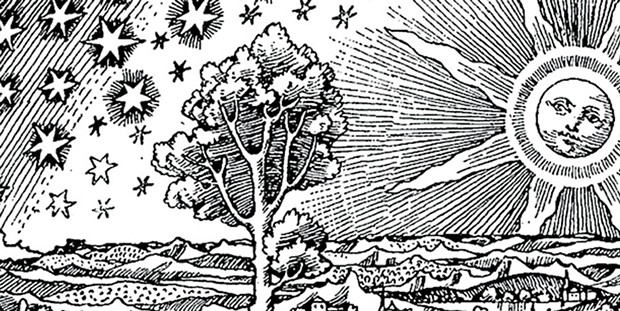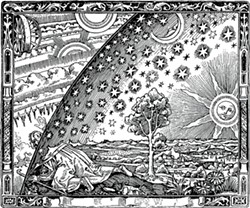[
{
"name": "Top Stories Video Pair",
"insertPoint": "7",
"component": "17087298",
"parentWrapperClass": "fdn-ads-inline-content-block",
"requiredCountToDisplay": "1"
}
]
Think you know science? Answer true or false:
1. The "Flammarion engraving" (above) dates to the Middle Ages.
2. Between 2000 and 2010, more murders occurred in New York City than in New York state.
3. There are more molecules in a glass of water than there are glasses of water in Earth's oceans.
4. More people are now alive than have ever died.
5. Earth's land area is greater than the entire surface area of Mars.
6. The U.S. government recommends drinking eight glasses of water a day.
7. Your fingernails grow at about the same speed at which the moon is drifting away from the Earth.
8. There are exactly seven colors in a rainbow.
Answers:
1. False. The popular wood engraving first appeared in 1888 in Frenchman Camille Flammarion's book on meteorology, although it does appear to be based on earlier drawings depicting medieval cosmology. It was probably created by Flammarion himself.
2. False. Any murder in New York City also occurred in New York state.
3. True, roughly by a factor of 1,000. World's oceans = 1.4 x 1021 liters = say 6 x 1021 glasses. Number of molecules in a mole of water (18 grams) = about 6 x 1023 (Avogadro constant), that is, 6 x 1024 molecules in a 180 gram glass of water.
4. False. People born since (say) 50,000 BC = 108 billion, 15 times present world population of 7.2 billion, according to data from the Population Reference Bureau.
5. True, just. Earth's land area = 149 million square kilometers, area of Mars = 145 million square kilometers. (Similarly, Europe's area is slightly more than that of the U.S., 10.2 vs. 9.8 million square kilometers.)
6. False. The myth arose from a spurious suggestion, made in 1945 by the National Academy of Sciences, to ingest 2.5 liters of fluids daily. It's now completely refuted.
7. True. Fingernails grow at about 1.5 inches per year, the same as the moon's outward drift (caused by tidal "braking" between the moon and Earth).
8. False. The human eye can distinguish around 100 colors in a spectrum. Isaac Newton gave us seven (after originally choosing five) following the belief of Greek Sophists that musical notes and color were intimately related: seven notes in a musical scale translated into the familiar ROYGBIV — red, orange, yellow, green, blue, indigo and violet. Most people can't distinguish indigo as a separate color.
Barry Evans ([email protected]) yearns to see, just once, a night-rainbow.
Comments (2)
Showing 1-2 of 2
more from the author
-
A Brief History of Dildos
- Apr 11, 2024
-
Eclipse!
- Mar 28, 2024
-
The Little Drone that Could
- Mar 14, 2024
- More »
Latest in Field Notes
Readers also liked…
-
Trouble on the Line: The Reality Part 2
- Nov 3, 2022


































